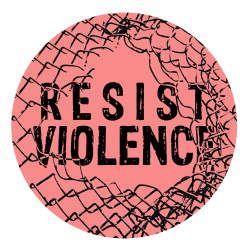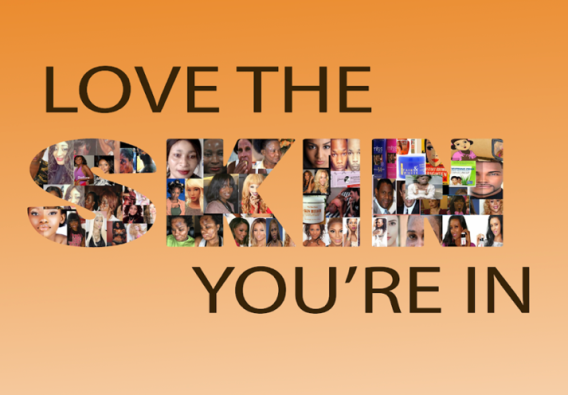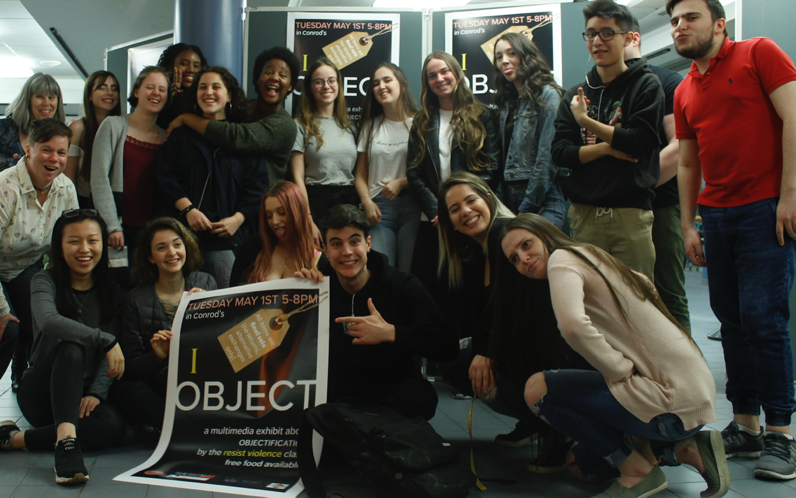Under the title, “I Object,” students in our Winter 2018 class developed creative projects that explored the theme of objectification. As they exposed the realities of sweatshops, imagined creative ways to make statements about the over-sexualization of women in the media, and provided a look at inter-racial, aging and queer couples in their intimate lives, they also became familiar with the practice of nonviolence. Many conveyed their pride in being able to express discontent over an injustice they perceived and, in so doing, gained the critical perspective they needed to ground their projects in a concept of resistance that went beyond a surface understanding. Collectively, they began to experience the potential for nonviolence to change the culture around them.
Our pedagogy

The Resist Violence pedagogy offers an integrative educational approach to respond to the violence in our communities. Its origin lies in a Learning Communities collaboration between a Humanities teacher, who for many years has explored the issues of violence, war and peace with her students, and a Cinema-Communications teacher and community activist. With their respective backgrounds, the choice to emphasize critical thinking, media literacy and artistic expression was fitting.
In terms of educational theory, our pedagogy reaches the whole student cognitively, emotionally, and creatively, incorporating new insights from neuroscience, particularly the work of Mary Helen Immordino-Yang on embodied brains and social minds.[1] As psychological work on cognitive biases reveals, students need to be motivated to reflect on their ideas and behaviour; consequently, exploring the roots causes of the violence being studied, the suffering inflicted, and the potential for change are important. Since ideas grounded in a particular “causal relationship” are most resistant to change, critical thinking is a necessary component of our pedagogy.[2]
Building on this critical inquiry, the media literacy component encourages students not only to examine the sociocultural world they inhabit with new eyes, but also to consider how their own ideas about violence were shaped or even manipulated. Finally, with the artistic expression component, students develop their own ways to subvert the cultural messages that surround them, potentially creating new self-identities as creators of culture, rather than passive consumers.
Initially, we viewed the focus on resisting violence as a means to minimize the extent to which our students might be overwhelmed by the material, and to deepen their critique of violence. However, as we explored the connections between art and activism, and the multiple entry points this approach provided, our students became more meaningfully aware of the violence in their real and virtual lives. With this realization, the potential impact of adopting a pedagogy that actively embraced nonviolence became apparent.
Beyond resistance
Today’s increasingly polarized culture is affecting the classroom, making it more difficult to address complex social issues, particularly those around gender, race, and violence. There is the risk that raising provocative issues will result in angry exchanges between students, and decades of research on how resistant we are to challenges to deeply-rooted ideas and values might make teachers wonder whether they should even bother. Despite our society’s significantly reduced approval of explicit racist and sexist beliefs, harmful stereotypes continue — often unconsciously — to shape much of our behaviour, particularly when we make quick decisions.
On this point, a recent meta-analysis of 573 experiments on “implicit bias” concluded that, while some studies reported changes in measures of implicit bias, very few tested these effects over time to assess their capacity to shift behaviour; and found that no strong evidence for such an impact existed.[3] Moreover, the authors contend that any reductions in implicit bias, achieved by a short-term intervention, would likely be erased when individuals were reintroduced to the cultural environment which supports them.
Current social psychological work on implicit biases is now shifting towards motivating people to pay attention to problematic stereotypes and biased behaviours, as well as the risks inherent to reactive, rather than reflective thinking and action.[4] This goal is central to our critical thinking and media literacy objectives. However, some psychologists have gone so far as to argue that we should really focus on “changing the sociocultural worlds in which those hearts and minds are immersed.”[5] This standpoint moves beyond the borders of psychology into the realms of activism and social change theory, and this applied focus on nonviolence is where our pedagogy finds its roots.
The transformative potential of nonviolence
As teachers, we practise nonviolence when we work to create spaces based on mutual respect, equality, and trust. Genuine dialogue cannot take place when we react with anger or humiliate others. Calling someone “racist,” “sexist” or even “privileged” will most likely be counterproductive and increase tensions in the classroom. Indeed, psychology provides much support for the positive effects that even a small generous gesture can have in a conflictual situation. A remark or question that causes an adversary to think of themselves positively can reduce the intensity of a difficult situation, leading to a greater willingness to make compromises in negotiations or an increased openness to a stigmatized “other.”[6]

What makes nonviolent activism inspiring, yet appear so impractical to many of us, is the extent to which its proponents ask us to distinguish the individual from their actions, even when confronted with their hatred and contempt. For Gandhi, the oppressor had to be persuaded, not coerced, to see the humanity of the “other.” This could only happen if the oppressed was able to demonstrate the truth of their convictions while treating their opponent as an equal or even a friend. Much can be learned from this view of humanity.
As Gandhi argued, appeals to reason have their role, but “arguments become disqualified when the people making them are not perceived to be worth listening to,” thus significant efforts are needed to move the other emotionally.[7] The work of sociologist Stellen Vinthagen expands our understanding of how nonviolent movements work, revealing the much more subtle dynamics that are at play beyond the very visible confrontational strategies that seek to disrupt the status quo, and it is these subtleties that can arguably be brought into the classroom. Luckily, there are examples of this all around us as we begin to explore artistic activism.
The ability of artistic activism to surprise us — to show up in unlikely places (e.g. not a gallery) or take on unfamiliar forms (e.g. not a protest march) provides an opportunity to disrupt peoples’ preconceived notions of art and protest, and their predetermined ideas about the messages we are trying to communicate. Artistic activism creates an opportunity to bypass seemingly fixed political ideas and moral ideals and remap cognitive patterns. Surprise is a moment when hearts can be touched and minds reached, and both changed.[8]
Artistic activism creates an opportunity to bypass seemingly fixed political ideas and moral ideals and remap cognitive patterns. Surprise is a moment when hearts can be touched and minds reached, and both changed.
While Gandhi viewed voluntary self-suffering as central to breaking through the emotional and cognitive barriers to see the humanity of the “other,” Vinthagen argues that it is not the suffering per se that is central, but rather one’s willingness to put oneself at some risk. Given human resistance to recognizing that our own complicity sustains injustice, the transformative potential of nonviolent action is enhanced when it expresses an appealing “utopian enactment,” as demonstrated by the sit-ins and wade-ins of the Civil Rights Movement.
With nine other blacks, Gilbert Mason went to Biloxi Beach, a forbidden part of the enormous coastline [in Mississippi]. There is a double dynamic when a black nonviolent activist is punished for having gone into a ‘whites-only’ beach, happily singing, wearing a swimming costume, carrying a packed lunch and accompanied by family and friends: the act is both risk-filled and utopian. When the activists are manhandled and put in jail, the brutality of those in power is exposed at the same time as the activists’ good intentions are made clear. Not only are the civil rights champions imprisoned, they are imprisoned because they tried to socialize with people of another skin colour on the beach on a nice, warm summer’s day.[9]
These types of actions — at once without, against and beyond violence — are, in essence, works of performance art that push more and more of us to take sides. As Vinthagen puts it, “Oppression becomes all the more grotesque and the vision of community all the more appealing when violence is exercised against constructive nonviolent activists who neither defend themselves (with violence) nor give up.”[10] Although we clearly never ask students to take extreme risks, we do ask them to study the ways in which nonviolence works, and its ability to evolve and surprise in the face of violence provides great inspiration.
Central to bringing change is the recognition that nonviolent activists are proposing a better future, one encompassing greater equality, freedom and mutual respect;[11] a vision appealing to most of us, but one that cannot be attained “as long as there are threatening people.”[12] The challenge for nonviolent movements is to make this aspiration recognizable to society. The more this happens, the more likely violent responses and the status quo are seen as illegitimate. As demonstrated, successful social movements often turn to art, using stories and music, powerful symbolism and images, or dramatic performances to unexpectedly capture our attention or activate our empathy. From our recent experience, it turns out the classroom is a great place to explore and participate in this.
What are the implications for the classroom?
As educators, we rarely have to confront the fear and dehumanization that exist in deeply-embedded systems of injustice, but we do face discriminatory attitudes and harmful ideologies. As we have explored, none of us is as open to new ideas as we like to think. Being confronted by knowledge that challenges our world view is threatening, and we often respond with defensiveness and denial to protect our self-identity. The need to ensure the integrity of our sense of self is so strong that even mundane events can trigger defensive mechanisms.[13]
Yet, the transformative capacity of nonviolence is subtle. Although this contributes to the tendency to link nonviolence to passivity, its subtlety is actually a strength: we are affected before our resistance can be activated. As educators interested in bringing about an openness to examine, and possibly change, deeply-rooted cultural ideas, we need to think more about how we can bring the element of surprise into the classroom. Finding more ways to incorporate art, story-telling, and inspiring examples of nonviolent activism into academic discussions is a start. Rather than begin with explicit discussions about social privilege, for example, we need to think more about how we can move students to unexpectedly recognize their own group’s advantages.

With the Resist Violence pedagogy, we are using the insights of nonviolence theory and practice, but also re-shaping the classroom environment by building social activism directly into the course. By engaging in artistic activism, students are able to think of themselves as not merely consumers of culture, but as agents of change. This is an empowering identity, but also one that brings responsibility, as it reveals a more sophisticated understanding of social power. Our students discover that power is not simply exerted from the top down, but continuously being reproduced in our everyday habits, through our beliefs, feelings and actions. Although difficult — as it involves us making the unconscious conscious — resistance becomes possible, and as students become more aware of this, it makes their choices in life more meaningful.
Student, Winter 2018
Activism seems too daunting to many of us, and perhaps too political for the classroom, but connecting it to art makes it accessible. It is a perfect vehicle for students to reveal how violence has affected their lives, to display the humanity of the “other,” and to create a vision for a better future. As students reflect on what is meaningful to them, they frequently respond unexpectedly to what is meaningful to others. And, as much as the committed activist’s willingness to put themselves at risk can move us, this powerful element of vulnerability is also inherent to the creative process. Hopefully beliefs shift, but even more significantly, a new self-identity may be developing as students engage with the sociocultural world that shapes them.
For more information on this ECQ-financed project, we invite you to take a look at our website where you can find modules on “othering,” rape culture and media violence. Pending further funding, we hope in a few weeks to invite faculty from across Dawson to work with us to further develop this pedagogy, while implementing a thorough evaluation process to access its effectiveness.
Footnotes
1] Mary Helen Immordino-Yang, “Implications of affective and social neuroscience for educational theory” Educational Philosophy and Theory 43:1 (2011): 98-103; “Embodied brains, social minds,” Pedagogical Day, keynote address, Dawson College, 17 October 2014.
2] Morgan P. Slusher and Craig A. Anderson, “Using causal persuasive arguments to change beliefs and teach new information: the mediating role of explanation availability and evaluation bias in the acceptance of knowledge” Journal of Educational Psychology 88:1 (1996): 110–122.
[3] Patrick S. Forscher et al., “Breaking the prejudice habit: mechanisms, timecourse and longevity” Journal of Experimental Social Psychology 72 (2017): 291-305; “A Meta-analysis of procedures to change implicit measures” PsyArXiv, 20 August 2018. Web.
[4] Forscher, “Breaking the prejudice habit”.
[5] Glenn Adams et al., “Beyond prejudice: toward a sociocultural psychology of racism and oppression” in G. Adams et al. (eds.), Commemorating Brown: the social psychology of racism and discrimination, (Washington, DC, American Psychological Association, 2008): 215–246, at 236.
[6] Geoffrey L. Cohen and David K Sherman, “The Psychology of change: self-affirmation and social psychological intervention” Annual Review of Psychology 65 (2014): 333–371, at 352-353.
[7] Stellan Vinthagen, A Theory of nonviolent action: how civil resistance works (London, Zed Books, 2015): 209.
[8] “Why Artistic Activism?” Centre for Artistic Activism, 9 April 2018. https://c4aa.org/2018/04/why-artistic-activism/.
[9] Vinthagen, Theory of nonviolent action, 220-221.
[10] Vinthagen, Theory of nonviolent action, 221.
[11] Vinthagen, Theory of nonviolent action, 218.
[12] Vinthagen, Theory of nonviolent action, 219.
[13] Cohen and Sherman, “Psychology of change,” 335.



